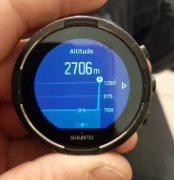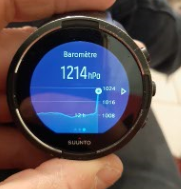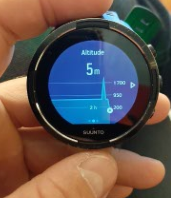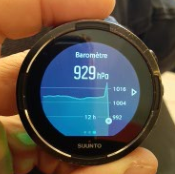Pressure should not change when the altitude is realigned ....
-

Executing a realignment of altitude recently I observed something which for me is abnormal.
Let’s imagine …
I’m at home at 703 m altitude.
My watch is perfectly giving me this altitude.
I will do the following- manually changing a first time the indication of altitude to 2703 m (so adding + 2000)
- manually changing a second time the indication of alitude this time to 3 m (so removing 2700m)
So let’s go and see what is happening …
After 1)
I see effectivelly in the altitude curve that the new alitude information displayed is effectively now set to ~2706 meters instead the original ~706 m
This is normal it was my wish …

BUT !!!
If now I look to the pressure curve, I see also a similar peak of pressure information which is tooking place at the same time, now indicating 1214 hPa instead of the ~1010 hPa before …

For me this is totally abnormal.
For sure, one will tell me that an altimeter is a “lying barometer” and in fact measure the pressure that it translate into meters … So altitude = f (pressure) … which means that pressure = f-1(altitude)
this is true … BUT !!!
like this : pressure = f-1(REAL altitude)
and not like that : pressure = f-1(DECLARED altitude) <— this is wrong
The pressure is a measure of a reality, like temperature is.If the baromatric captor tells me that now where I’m sitting, the pressure is 1000 hPa
whatever altitude information I will indicate, the pressure has not changed … just because I’m not moved or because the weather does not change in 1 minuteSo even if I now tell that I’m at 2707 or even 8707 m or 7m at sea level, the indication of pressure is shown should remaind the exact same … the pressure is a measure of a reality in itself …
After 2)
I confirm the same strange behavior …
I now tell to the wath that I’m around ~7 m

and the watch do this wrong adjustment also on the pressure

Conclusion
For me the change of pressure on an altitude realigment is an error.
Moreover it could lean to false conclusions
At my home, in front of my TV … in 5 minutes I moved from a pressure of 1010 hPa to 1214 hPa then to 929 hPa … moving from the most beautiful weather to the heaviest raining one …
Was it raining like hell in my livign room ??? No hopefuly
Recall
Atmospheric pressure is the pressure of the air at a precise place.
It is the weigth of all the air which is between your feet and the summit of atmosphere
As such, if you measure it within a short range of time, it is a constant, so should not be influenced by anything.
Of course in reverse if you measure it at the same place before going to bed and after wakeup, if the weather changed, then the pressure will change … then the barometrics altimeters will also see their altitude changing (an higher altitude than the day before if the weather was becoming better, or lower altitude than the day before if the weather is becoming worth)
This is why we call altimters = lying barometers
This is also how we can guess how the weather is becoming thanks to an altimeter.For the fun …
The highest pressure observed in France is 1048,9 hPa, March, 3 1990 at Chemoulin
The lowest pressure observed in France is 951.8 hPa, February, 25 1989 at la Hague
I broke these 2 records in 5 minutes at staying in my home …
Very interresting doc to read (unfortunatelly in french)
=>
https://www.meteocontact.fr/pour-aller-plus-loin/la-pression-atmospherique
http://leguidemeteo.com/prevoir-le-temps-a-partir-de-son-barometre/ -
@mister-pyc ok, this is a long post. Maybe the aswer can be short.
There are two variables here: altitude and pressure. Both are not independent, but linked through the current weather condition. This weather condition is indicated by something called “sea level pressure” and this is what also weather reports show.
The absolute pressure at a given point and a given time depends on the sea level pressure and the altitude - it can be calculated with a specific formula.
The watch has a sensor that measures only the absolute pressure as a fixed point. You have now two variables as user input to the watch, to tell it, how to interpret this absolute measurement.
a) pressure: If you enter the sea level pressure from a nearby weather station as a reference, the watch now has absolute and sea level referenced pressure. It can calculate the altitude from this.
b) altitude: If you enter the reference altitude, the watch has now the absolute pressure and the current altitude. It can now calculate the sea level referenced pressure from this.So if you change the altitude manually, the sea level pressure needs to adjust to match it with the internal barometer absolute value.
-
-
@egika said in Pressure should not change when the altitude is realigned ....:
The watch has a sensor that measures only the absolute pressure as a fixed point.
Hello Egika it’s a very very very good answer. a brilliant one indeed which perfectly explain the mathematics around altitude and pressure and how the watch work with it
also it helped me to understand why my noise was smelling something weird here
And there is still a problem
it took me some times to put the finger on it … and … I have itThe mathematical is perfect and effectively giving the feeling that we are in front of a normal behavior of the watch as said by Brad
So sure it is totally correct ???
hummPerfectly correct for the new information which are displayed :
the new altitude is my wished one and the sea level pressure is deducted as it is a mathematical computation of it and the real pressure that the baro observePERFECT … Here I’m killed

BUT … … … . .
If we want to be really totally correct then ALL the historical values should have been also revisited …The measures that were done 10 minutes before or one hour before
were indeed also wrong and should also be impacted by this adjustment of altitude …The reason is simple : 10 minutes before when the watch was telling me “you are at 700m” and I adjusted – of course very exaggerated – to 2700m … I was not climbing 2000m in 10 minutes, neither the pressure moved from sea level 1010hPa to now 1214hPa.
So if we want to be totally correct
- Either the historical datas should be wiped out – which is absolutelly not good –
- Or the historical datas should be also realigned with the same adjustment correction done
All the altitudes should be shifted by + 2000 m and all the pressure is also shifted by this + 204 hPa that the watch adjusted
Doing such then all is correct and coherent.
I was wrong since a long time, now I’m correct
and the pressure is stable … or … if there are some variations it is real variations that the watch observedPS : sorry for my long answer; I’m french and my english is not good enough to be able to synthetize in better words my thoughs.
-
To make it short :
The computation for new pressure value as per my manual correction is totally correct
BUT, still what is wrong is that it should have been echoed on all the past data to also make them correct. -
Shouldn’t it then also correct the altitude for the past ? And then again till what value in the past ?
I think this should happen only if the adjustment happens automatically and not manually and maybe only for pressure ?
It’s both right and wrong what you ask


-
You are perfectly correct
So when I try to summarize … I’m not yet super good
It was exactly what I wrote in the above much longer post.For me, both the altitude and the pressure current but also past data should be corrected.
After that it open 2 questions :
-
As you said unti when in past … I do not know what is the range kept in the watch … so I cannot answer … it is it only for what it is displayed on the screen, then I will say … ALL …
-
Still something on which I will think … what will happen in case you do a course, you start with a good calibration at a refuge at 1000m with a perfect weather, you arrive to a summit which should be at 2500m, in between the weather changed and now is bad, the watch is indicating 2800m… if I adjust the altitude … and put 2500 m … how this will imlpact the past ??? …
Humm finally do nothing ?
or adjust only what the watch can display in order to avoid these strange peak effect ? -